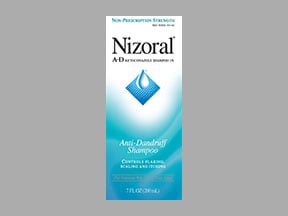
Nizoral A-d Coupons & Savings Card – Discount Prices from $16.84
My prescription
Edit
125ML of 1%, Nizoral A-d (1 Bottle)
Select pharmacy

Walgreens
$16.84
COUPON PRICENizoral A-d savings card
Show this card to your pharmacist
Walgreens
$16.84
BIN
ID
PCN
GRP
019876
LH79DBF1F6
CHIPPO
LHX
Powered by
More prescriptions for tinea versicolor
More prescriptions for tinea versicolor
Price history for Nizoral A-d (generic)
1, 125ML of 1%
Average retail price for Nizoral A-d
Average SaveHealth price for Nizoral A-d
Our price history data is based on aggregated prescription data collected from participating pharmacies in America. Our prescription data updates daily to reflect the latest price changes. If you notice a missing data point, it means there wasn't sufficient data available to generate a monetary value for that date.
Nizoral A-d dosage forms
| Dosage | Quantity | Price from | Per unit |
|---|---|---|---|
| 125ML of 1% | 1 Bottle | $16.84 | $16.84 |
Nizoral A-d Warnings
The following outlines crucial safety warnings associated with the use of ketoconazole (Nizoral A-D). It is essential to read these carefully and discuss any concerns with your healthcare provider.
Allergic Reactions: Users may experience serious allergic reactions, including anaphylaxis, which can be life-threatening. Symptoms such as hives, rash, swelling of the lips or tongue, or difficulty breathing require immediate medical attention. In case of severe reactions like throat closure, call emergency services immediately.
Toxicity if Ingested: Ketoconazole (Nizoral A-D) is intended strictly for topical application on the scalp and skin. Ingesting it poses significant health risks. To prevent accidental ingestion, keep the medication out of reach of children and pets. If ingestion occurs, contact a poison control center without delay.
Please ensure these warnings are followed to use ketoconazole (Nizoral A-D) safely and effectively.
Nizoral A-d Side Effects
When using this medication, you may notice some changes in your hair and scalp, such as abnormal hair texture, changes in oiliness or dryness, or even discoloration. Occasionally, you might experience irritation or pimple-like bumps on the scalp. These side effects are generally mild, but if they persist or worsen, it’s advisable to consult your healthcare provider.
Some individuals may also experience itching, irritation, or dry skin, which are common and typically mild. However, if these symptoms continue or become bothersome, reaching out to your healthcare provider is a good step.
More noticeable side effects like changes in hair texture or color, loss of curl in wavy hair, or hair loss have been reported by some users. Additionally, some may experience a rash or a burning sensation. While these are less common, it's important to monitor these symptoms and consult your doctor if they occur.
On rare occasions, a serious allergic reaction could occur, marked by rash, itching or swelling, severe dizziness, or breathing difficulties. These are considered serious and necessitate immediate medical attention. Always be attentive to any new or worsening symptoms and seek help as needed.
What is Nizoral AD used for?
Nizoral AD is used as an over-the-counter medicated shampoo to treat dandruff and relieve symptoms such as flaking, scaling, and itching associated with it. It contains ketoconazole, an antifungal agent that helps reduce the growth of yeast on the scalp, which can contribute to dandruff.
What is the active ingredient in Nizoral AD?
The active ingredient in Nizoral AD is ketoconazole.
Can you use Nizoral on your groin?
Yes, Nizoral (ketoconazole) can be used on the groin area to treat fungal infections such as jock itch. It is important to follow the instructions on the product label or those provided by a healthcare professional. The area should be clean and dry before application, and hands should be washed after applying the medication. If there is any irritation or if the condition does not improve, it is advisable to consult a healthcare provider.
What skin conditions are treated with Nizoral?
Nizoral, which contains the active ingredient ketoconazole, is used to treat various fungal skin conditions. These include seborrheic dermatitis, tinea versicolor, and other fungal infections like ringworm and athlete's foot. It works by reducing the growth of fungi on the skin.
